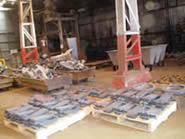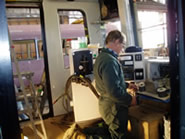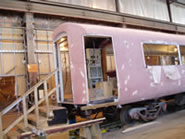Hillside
Continuing Work
There are other things Hillside is involved with which are unique to the site and based around the foundry. The casting process and casting technology is applied to the industry. Hillside makes bolsters, side frames and bogies for the rail industry. There are also a number of consumable products for sub-assembly components which they provide for other industries, for example the Aluminium Smelter – these being for the aluminium piped reduction processes that occur there. Stainless steel knife gauge valves are exported to Australia – Hillside manufactures them, then casts and machines the body.
There is a physical testing laboratory on site which supports metallurgical processes at the site as well as destructive and non-destructive testing.
A computer modelling process helps the team design methods to support the best solidification process.
Fitting out of carriages is a major job and will include design from manufacture elements. As a product develops the team takes the lessons learnt from it, for example how fibre glass panels fit. It incorporates changes to the design then makes the process more efficient to get a better quality product.
Process improvements are an important part of the workplace and the company recognises improvements people come up with, for example in health and safety. Applying technology in this area can save time and costs as well as eliminate risks.
Retrofitting of old locomotive systems is part of the continual work load. The company is always maximising the asset value of these locos by upgrading and retrofitting. Albert comments that it 'cutting edge' OEM (Original Equipment Manufacturer) development going on.
Loco and carriage refurbishment is also carried out for organisations such as the Taieri Gorge Railway, which is a major tourist attraction in Otago.
Plans for the future revolve around rolling stock for freight transport and building for passenger transport in New Zealand. With the relationship already developed there are potential opportunities in Australia.
Vehicle dynamics type testing and research is conducted by Hillside. They are asked to validate any new vehicles introduced into New Zealand in the track environment for both themselves and other companies. This includes extensive dynamic testing with the research car, with assessments and informal reports are provided to Land Transport New Zealand (LTNZ).
The design crew has a mixture of tertiary qualification as well as those from a trade background coming through the ranks. They have to be project focussed and realistic – when committed to a contract they have to deliver. They have a lot of experience working to tight deadlines, high specifications and tough auditing by clients. They have to deliver the product to world standards and be critiqued by rail experts.
The team decides the compliance standard because they are effectively self regulating. They must justify what they've done to LTNZ and then defend it to peer review. There is no rule where they can look it up and say they've done the job, so in almost all judgements they have to defend the compliance judgement. There are international standards but different rules in each country so they are subjected to everyone's definition. There is a lot of professional judgement that is continuing and ongoing in the rail industry in New Zealand, more so than in many others due to this self regulation. The staff manages and makes judgements on fire standards and crash worthiness and continually do risk assessments – all under the compliance banner they provide.
Hillside Engineering Group looks to continue with the work it has been doing, as well as pursuing opportunities to negotiate new contracts to provide locomotives and carriages.



